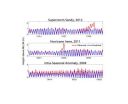(Press-News.org) This study of 963 children aged 14 and 15 in Norwegian schools found a high incidence of post-traumatic stress disorder (PTSD) symptoms among bullied pupils. These signs were seen in roughly 33 per cent of respondents who said they had been victims of bullying.
"This is noteworthy, but nevertheless unsurprising," says psychologist Thormod Idsøe from the Universitiy of Stavanger (UiS) and Bergen's Center for Crisis Psychology. "Bullying is defined as long-term physical or mental violence by an individual or group.
"It's directed at a person who's not able to defend themselves at the relevant time. We know that such experiences can leave a mark on the victim."
He has published an article on "Bullying and PTSD symptoms" in the Journal of Abnormal Child Psychology with colleague Ella Maria Cosmovici Idsøe at the UiS Centre for Behavioural Research and psychologist Atle Dyregrov from the Center for Crisis Psychology.
The study measured the extent of intrusive memories and avoidance behaviour among pupils. These are two of three defined PTSD symptoms. The third, physiological stress activation, was not covered.
High levels of defining signs
Recent research on working life has found that 40-60 per cent of adult victims of bullying reveal high levels of these three defining signs.
But few national or international investigations have been conducted on the relationship between being bullied and PTSD symptoms among schoolchildren.
"Traumatic experiences or strains imposed on us by others can often hurt more than accidents," says Idsøe. "That could be why so many pupils report such symptoms."
They can cause great difficulties concentrating, have a disruptive effect and prevent sufferers from functioning normally in daily life. Idsøe has personally seen how PTSD symptoms can create problems for schoolchildren.
"Pupils who're constantly plagued by thoughts about or images of painful experiences, and who use much energy to suppress them, will clearly have less capacity to concentrate on schoolwork. Nor is this usually easy to observe – they often suffer in silence."
More girls
The research also shows that girls are more likely to display PTSD symptoms than boys, Idsøe reports. "That accords with studies of other types of strain.
"We also found that those with the worst symptoms were a small group of pupils who, in addition to being victims of bullying, frequently bullied fellow pupils themselves."
He finds it difficult to provide a definite explanation of why some groups are more likely to develop PTSD symptoms, but says this question is a general issue among trauma specialists.
"One explanation, for example, could be that difficult earlier experiences make the sufferers more vulnerable, and they thereby develop symptoms and mental health problems more easily."
Awareness
He hopes that the study's findings can help to boost awareness that a number of bullied schoolchildren may need support even after the mistreatment has ended.
"In such circumstances, adult responsibility isn't confined to stopping the bullying. It also extends to following up the victims."
Idsøe and his co-researchers have not investigated how much help bullied pupils get afterwards, but their impression is that such follow-up remains inadequate.
Immediate
"We know that Norwegian schools devote much attention to putting a stop to bullying it, and that pupils who need immediate support do receive it," Idsøe says.
"But we also see that such assistance stops too early. Although the bullying may have ended, PTSD symptoms could persist for a long time with some children."
In his view, teachers and schools should be aware of the need certain pupils might have for long-term follow-up. In some cases, that could also require the involvement of the health service.
"It's important to monitor how pupils develop after being bullied, and to be aware of the possibility that they might develop PTSD symptoms.
"It's not always easy to spot that a child is being plagued by intrusive memories and avoidance strategies. So teachers must be offered more information on these conditions.
"They need to know how to detect that a pupil needs to be referred on, and must be able to tailor teaching for children with such difficulties."
Limitations
Idsøe acknowledges that the study has its methodological limitations, and that more detailed studies of the link between bullying and PTSD are therefore required.
"Although we asked about PTSD symptoms related to episodes of bullying, we can't exclude the possibility that the responses may relate in some cases to other traumatic incidents," he says.
To study this in more detail, the researchers will now join a Finnish study of 1 100 schoolchildren to check the relationship between bullying and PTSD symptoms regularly over several years.
Idsøe also belongs to a national research group investigating the link between being bullied and the psychiatric diagnosis of PTSD. That involves more criteria than a high level of symptoms.
INFORMATION:
Being bullied can cause trauma symptoms
2012-11-27
ELSE PRESS RELEASES FROM THIS DATE:
Scientists at the Institute of Molecular Biology identify key event for sex determination
2012-11-27
Scientists at the Institute of Molecular Biology (IMB) in Mainz have identified a protein essential for initiating the development of male sex organs. Loss of the gene Gadd45g results in complete sex reversal of male mice, making them appear female. The researchers' finding uncovers a novel signaling cascade, which acts early in development to determine the gonads in males. This discovery sheds light on the genetic network that controls how embryos develop as males or females. The research has just been published in the high-impact journal Developmental Cell.
Research ...
Research reveals new understanding of X chromosome inactivation
2012-11-27
Chapel Hill, NC – In a paper published in the Nov. 21 issue of Cell, a team led by Mauro Calabrese, a postdoctoral fellow at the University of North Carolina in the lab of Terry Magnuson, chair of the department of genetics and member of the UNC Lineberger Comprehensive Cancer Center, broadens the understanding of how cells regulate silencing of the X chromosome in a process known as X-inactivation.
"This is a classic example of a basic research discovery. X-inactivation is a flagship model for understanding how non-coding RNAs orchestrate large-scale control of gene ...
Preventing posttraumatic stress disorder by facing trauma memories
2012-11-27
Philadelphia, PA, November 27, 2012 – Posttraumatic stress disorder (PTSD) is a form of learning that begins at the moment of the exposure to extremely stressful situations and that grows in impact as trauma-related memories are rehearsed and strengthened repeatedly. This somewhat oversimplified view of PTSD yields a powerful prediction: if one could disrupt the rehearsal and strengthening of traumatic memories, a process called reconsolidation of memories, then one might reduce PTSD risk or PTSD severity after potentially traumatic events.
To be certain, it is tricky ...
Enzyme explains angina in diabetics
2012-11-27
In a new study published in the scientific journal Circulation, scientists at Karolinska Institutet and Karolinska University Hospital in Sweden show that an enzyme called arginase might have a key part to play in the development of cardiovascular disease in patients who already have type II diabetes. According to the team, arginase prevents the formation of protective nitrogen oxide in the blood vessels, and treatments that inhibit this enzyme reduce the risk of angina in diabetics.
"The fact that we could demonstrate the presence of arginase in several types of cell ...
New method for diagnosing malaria
2012-11-27
Malaria is a life-threatening disease that strikes more than 200 million people every year – mainly in Africa, Asia and Latin America. The disease is caused by the Plasmodium parasite, which is spread by infected mosquito bites. Today, malaria can be prevented and successfully treated, but more than half a million people nevertheless die every year from the disease.
Large-scale monitoring and treatment programmes during the past decade have reduced the distribution of the disease, and the frequency of actual epidemics has fallen. However, the number of malaria patients ...
A rather thin and long new snake crawls out of one of Earth's biodiversity hotspots
2012-11-27
Field and laboratory work by a group of zoologists led by Omar Torres-Carvajal from Museo de Zoología QCAZ, Pontificia Universidad Católica del Ecuador, has resulted in the discovery of a new species of blunt-headed vine snake from the Chocoan forests in northwestern Ecuador. This region is part of the 274,597 km2 Tumbes-Chocó-Magdalena hotspot that lies west of the Andes. The study was published in the open access journal ZooKeys.
Blunt-headed vine snakes live in an area comprising Mexico and Argentina, and are different from all other New World snakes in having a very ...
Three new arthropod species have been found in the Maestrazgo Caves in Teruel
2012-11-27
A team of scientists from the University of Navarra and the Catalan Association of Biospeleology have discovered three new collembolan species in the Maestrazgo caves in Teruel, Spain. Their description has been published in the Zootaxa journal. These minute animals belong to one of the most ancient animal species on the planet.
The Maestrazgo caves in Teruel are located in a region of the Iberian Range where fauna has not been the subject of much study. It is a very isolated region since its average altitude is between 1,550 m and 2,000 m asl and its climate can be described ...
New test to help heavy drinkers reduce alcohol intake
2012-11-27
Researchers at the University of Liverpool have developed a computer-based test that could help heavy drinkers reduce their alcohol consumption.
Regular heavy drinking can lead to serious health conditions such as liver and heart disease, costing the NHS millions of pounds every year. Research at Liverpool has shown that the habit of consuming alcohol can be interrupted when people practice methods of restraint whenever they see images of alcoholic drinks.
The team developed a computer test that required participants to press particular buttons when an image of alcohol ...
Paralysis by analysis should not delay decisions on climate change
2012-11-27
Uncertainty about how much the climate is changing is not a reason to delay preparing for the harmful impacts of climate change says Professor Jim Hall of the Environmental Change Institute at the University of Oxford and colleagues at the Tyndall Centre for Climate Change Research, writing today in Nature Climate Change.
The costs of adapting to climate change, sea-level and flooding include the upfront expenses of upgrading infrastructure, installing early-warning systems, and effective organisations, as well as the costs of reducing risk, such as not building on flood ...
Researcher studies 'middle ground' of sea-level change
2012-11-27
The effects of storm surge and sea-level rise have become topics of everyday conversation in the days and weeks following Hurricane Sandy's catastrophic landfall along the mid-Atlantic coast.
Ongoing research by professor John Brubaker of the Virginia Institute of Marine Science is throwing light on another, less-familiar component of sea-level variability—the "intra-seasonal" changes that occupy the middle ground between rapid, storm-related surges in sea level and the long-term increase in sea level due to global climate change.
"These are cases when the water is ...





